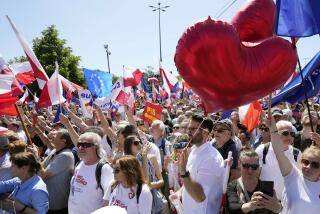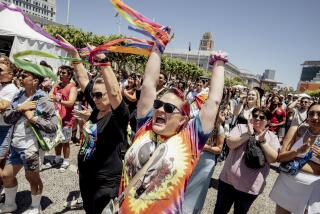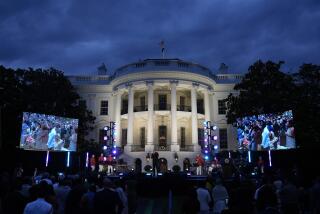One man’s quest for Loving Day, a holiday for multiracial Americans
Forty-nine years ago on June 12, the Supreme Court struck down laws in 16 states that banned mixed-race marriages. The decision in Loving vs. Virginia overturned the conviction of Richard and Mildred Loving, an interracial couple from Caroline County, Va., who had been arrested, jailed and banned from their home state for violating its Racial Integrity Act.
It also ushered in a new era in the American family.
Today, the Pew Research Center counts 22 million multiracial Americans, about 6.9% of the U.S. population. Nearly 10% of married couple households -- more than 5 million -- are interracial or inter-ethnic, according to the U.S. census.
For 12 years, Ken Tanabe, a Japanese-Belgian freelance graphic designer living in New York, has been working to educate Americans about what he sees as one of the most significant civil rights cases through Loving Day, the unofficial holiday that cities across the country are slowly adapting to celebrate the lives of the fast-growing multiracial population.
Now Tanabe, whose organization has tracked and sponsored many of the dozens of dance and music festivals, film screenings, picnics and forums taking place across the country in June to commemorate Loving vs. Virginia, has launched a campaign to get the holiday recognized by the federal government.
The Times spoke to Tanabe, 38, about the multiracial experience and Loving Day, which lands a week before another major observation related to race: Juneteenth, a commemoration of the day – June 19, 1865 – that the abolition of slavery was announced in Texas, one of the last strongholds of the Confederacy.
Questions and answers have been edited for length and clarity.
How did Loving Day get started?
It started as my graduate thesis at Parsons School of Design in New York. I studied graphic design and wanted to do a design-driven social change program.
My dad is from Japan and my mom is from Belgium. I’m the first American in this family of an international, interracial couple. But growing up in Washington, D.C., and Bethesda, Md., I had never been exposed to Loving vs. Virginia. I was googling one day and sort of accidentally stumbled upon the case. I thought, “Wow, this is a milestone for civil rights.” I spoke to my parents and relatives and said, “Do you know of this case?” They said, “Of course, it was front-page news.” Yet somehow I had never heard of it.
Everyone who is ethnically ambiguous gets the ‘What are you?’ question. The other version of it is, ‘Where are you from?’
— Ken Tanabe, founder of Loving Day
My parents got married in 1971, just a few years after the Supreme Court decision. They traveled in a pretty international group. My dad worked for the Washington Post book review, and my mom worked in an embassy. I don’t think they went through a lot of trouble for their marriage in their circle, but I definitely remember getting weird looks as a kid when I was with them.
When you explain civil rights history to kids, you mention Rosa Parks, lunch counters, Martin Luther King Jr. Yet there is not much of a framework for multiracial couples. It struck me that Loving vs. Virginia could be a huge entry point.
What happens on Loving Day?
It really ranges. In Los Angeles, there is the Mixed Remixed Festival at the Japanese American National Museum. In New York, we’re inviting 1,000 people to the East River waterfront for a big party with drinks, music, a food truck, dance, kids’ activities and more. Kids and parents can sit down at the event to write letters to President Obama about recognizing Loving Day.
------------
For the record, June 10 12:12 p.m.: An earlier version of this story said that as many as 1,000 attended the New York event in 2004. Roughly 100 people attended the event.
------------
Our first year, in 2004, we had maybe 100 people at a bar in New York. It was very do-it-yourself, and just people together mingling, plus a few speakers. The second year, we got 300 people to come out to a different bar, and by the third year we had 500 people. In Federal Way, Wash., there’s a big barbecue, and in Richmond, Va., there’s a screening this year of HBO’s “The Loving Story” documentary. In some places, the format is more academic, like at an international forum taking place for the fourth year in Amsterdam.
In your writings and appearances, you describe a “shared multicultural experience.” What is it?
Everyone who is ethnically ambiguous gets the “What are you?” question. The other version of it is, “Where are you from?” Or there’s our hair. Multiethnic people have unusual hair; it’s pretty common. It’s the idea that you sometimes belong in multiple cultural spaces that you’re able to navigate. It’s that strange side-effect where people think you are one identity and don’t realize you have another identity as well, so they start saying bad things about that other identity. It’s the sense sometimes of not fitting in.
You currently have under 2,000 signatures on your White House petition to establish Loving Day as a holiday. You need 100,000 to get a response from the White House. What progress have you made with these efforts?
Loving Day is recognized in a bunch of American cities. In New York, it’s been declared in Manhattan and Brooklyn. There have been proclamations in Los Angeles and El Cerrito, Calif., in Eugene, Ore., and Washington, D.C. And of course Caroline County, Va., where the Lovings lived, observes it. Outside of our efforts, there are some areas around the U.S. that even have official holidays to recognize multiracial people.
How would you assess the conversation on race in America?
The collective consciousness around race is definitely maturing in this country. The conversation is becoming more nuanced. Racism is being acknowledged as a systemic problem. There are things like #OscarsSoWhite, #StarringJohnCho, Black Lives Matter. They’re all creating a deeper conversation about race.
There’s also more of a consciousness around being multiethnic or multiracial. Our whole purpose is to encourage people, wherever they live and whoever they are – even if not multiracial – to celebrate the diversity in the country and the possibility of loving who you love.
#myLovingDay: How the Lovings trials paved the way for today’s multiracial families
What’s your Loving story: A snapshot of your multiracial family
Jaweed Kaleem is The Times’ national race and justice correspondent. Follow him on Twitter and Facebook.
More to Read
Sign up for Essential California
The most important California stories and recommendations in your inbox every morning.
You may occasionally receive promotional content from the Los Angeles Times.











